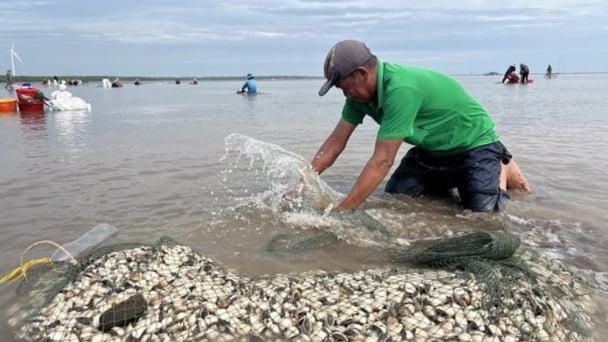May 28, 2025 | 17:41 GMT +7
May 28, 2025 | 17:41 GMT +7
Hotline: 0913.378.918
May 28, 2025 | 17:41 GMT +7
Hotline: 0913.378.918
Currently, the entire Hau Giang province has 680 hectares of growing soursop, concentrated mainly in Phung Hiep district, some districts of Chau Thanh and Long My, and Nga Bay city. When transforming to specialized cultivation, gardeners have applied the pond apple root grafting technique to increase the plant's adaptability and applied science and technology to improve productivity and quality. With an average yield of more than 12 tons of fruit/ha, the annual harvest output reaches about 8,200 tons.
Among them, Hamlet 2, Thuan Hoa commune, Long My district is where farmers grow a lot of soursop and have formed cooperatives to link production, support each other in applying technical processes, and invest in equipment to process into many products with high added value.

Soursop trees grafted with pond apple roots adapt to alum and salinity conditions, live long, and bear lots of fruit, bringing high economic efficiency. Photo: Trung Chanh.
The family of Ms. Tran Thi Thuy Tien in Hamlet 2 (Thuan Hoa commune) has 1.7 hectares of land and converted 0.5 hectares to soursop growing in 2017. According to Ms. Tien, soursop trees grafted with pond apple roots are suitable for growing in flooded, alum-contaminated, and saltwater-contaminated lands. The soursop tree grafted with pond apple root not only grows strongly and lives long but also bears a lot of fruit.
Ms. Tran Thi Thuy Tien said, "Previously, soursop farmers let the tree pollinate naturally, so the fruits were few. Later, thanks to the application of pollination techniques, the fruits not only set a lot but are also large, round, and have a beautiful design when harvested." Therefore, when the trees are in flowering and fruiting season, farmers must watch the flowers bloom to collect pollen and pollinate around the garden.
Additionally, farmers also apply the technique of spreading crops without concentrated pollination. Trees that bear a lot of fruit at the same time will not have enough strength to nourish the fruit, so the fruit will be small, and the efficiency will not be high.

Soursop trees grafted with pond apple roots need to apply pollination techniques to produce large, round fruits with beautiful designs and easy consumption when harvested. Photo: Trung Chanh.
According to members of the Soursop Cooperative in Hamlet 2, soursop trees grafted with pond apple roots, if planted and cared for properly, will bring very high economic efficiency. For many years, the selling price of soursop has always been at 50,000–60,000 VND/kg, even up to 120,000 VND/kg at the highest point. With a harvest yield of 12–15 tons/ha, soursop farmers earn a revenue of up to 600–800 million VND/ha. After deducting costs, the profit is hundreds of millions of dongs, much higher than rice growing.
In Long My district, when the district was first divided, the area of soursop growing was only about 5 hectares. After more than 10 years of focusing on investment, the area has increased to more than 120 hectares and has become a staple crop with high economic value.
In order to help farmers effectively develop soursop trees grafted with pond apple roots, in addition to training and technology transfer, the district's agriculture sector also supports seedlings, organic fertilizers, automatic irrigation systems, fruit bags, etc.

The soursop garden of Ms. Tran Thi Thuy Tien's family has now been pollinated, is in the fruit-nourishing period, and will be harvested in a few months. Photo: Trung Chanh.
Mr. Lam Van Viet, Head of the Agricultural Extension and Agricultural Services Station of Long My district, said, "The soil in many places in the district is heavily contaminated with alum and saltwater intrusion in the dry season, so low-lying areas for rice growing bring low economic efficiency. Therefore, the district chose soursop trees to plant and applied the pond apple root grafting technique, so they are well adapted to alum and salinity soil conditions, bringing much higher economic efficiency.
Thanks to the conversion from ineffective rice land and mixed gardens to growing soursop with pond apple-grafted roots, many farmer households in Hau Giang have had a good income. Not only selling fresh fruit, many households also invest in equipment to process it into custard apple tea, custard apple jam, custard apple wine, etc., helping increase profits.

Ms. Tran Thi Thuy Tien converted her family's ineffective rice-growing area to growing soursop with pond apple-grafted roots, bringing in many times higher income. Photo: Trung Chanh.
According to the development orientation, Hau Giang province will expand the area of specialized soursop cultivation to 1,000 hectares, with a harvest output of about 10,000 tons of fruit in 2025. Build cooperatives and cooperative groups to develop along the value chain, link with businesses, and strengthen research on deep processing technology to develop Hau Giang custard apple products. At the same time, support gardeners to apply GAP and organic production processes, thereby opening up development directions for post-processed and exported products.
Translated by Thu Huyen

(VAN) FAO’s Director-General addresses the 5th Baghdad International Water Conference.
/2025/05/26/1716-4-nongnghiep-191706.jpg)
(VAN) Chain linkages, technological innovation, and raw material zoning are three strategic pillars for the coconut industry to strongly develop and elevate its position on the global agricultural map.
![Advanced mariculture – an inevitable trend: [4] Accompanied by scientists](https://t.ex-cdn.com/nongnghiepmoitruong.vn/608w/files/sohk/2025/05/13/1941-pgsts-vo-van-nha-140958_717.jpg)
(VAN) According to Assoc. Prof. Dr. Vo Van Nha, Director of the RIA III, the development of advanced offshore mariculture is no longer an option but an essential path for Vietnam’s fisheries sector.

(VAN) Vietnam is intensifying the development of mollusk farming areas that meet international standards, aiming for sustainable growth and enhancing its export position in the global seafood market.
![Advanced mariculture – an inevitable trend: [3] Policy-driven momentum](https://t.ex-cdn.com/nongnghiepmoitruong.vn/608w/files/doanhtq/2025/05/21/0104-0616-0348-nuoi-bien-170339_789.jpg)
(VAN) To ensure the success of offshore mariculture that uses advanced technologies, it is essential to establish supportive policies that inspire both individuals and enterprises to invest with confidence.
![Advanced mariculture – an inevitable trend: [2] Outstanding results](https://t.ex-cdn.com/nongnghiepmoitruong.vn/608w/files/sohk/2025/05/12/4632-4136-nuoi-bien-11-164117_819.jpg)
(VAN) Pilot models of high-tech offshore mariculture in Vietnam, particularly in the South Central Coast region, have demonstrated exceptional economic returns and sustainability, setting a new direction for the country’s aquaculture industry.
![Advanced mariculture – an inevitable trend: [1] Moving offshore](https://t.ex-cdn.com/nongnghiepmoitruong.vn/608w/files/phucpm/2025/05/18/0252-2436-nuoi-bien-6-162148_783.jpg)
(VAN) Mariculture using advanced technology and moving offshore is an inevitable trend, as nearshore areas increasingly reveal limitations.